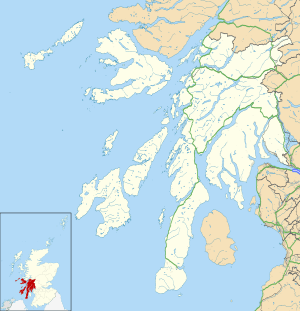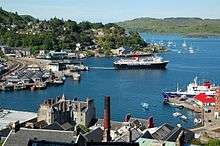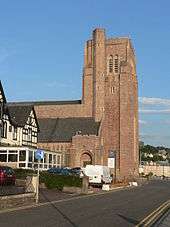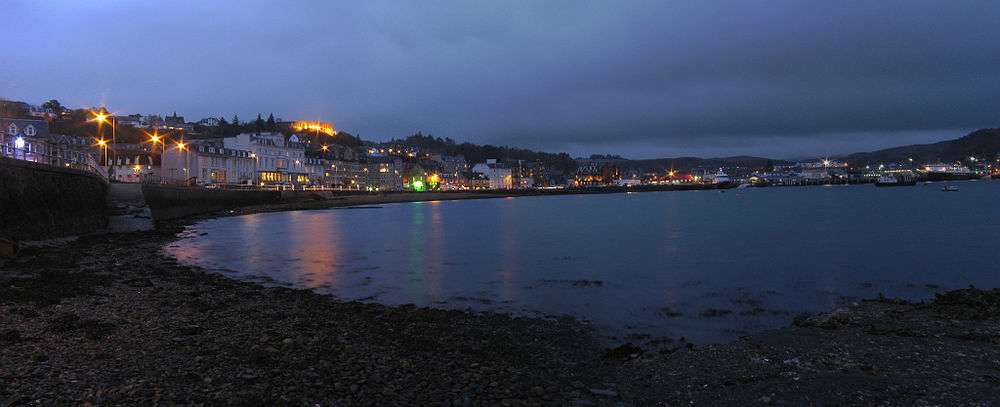Oban
Oban (/ˈoʊbən/ (![]()
| Oban | |
|---|---|
 Oban from Druim Mor | |
 Oban Location within Argyll and Bute | |
| Population | 8,575 (2011 Census) |
| OS grid reference | NM859298 |
| • Edinburgh | 93 mi (150 km) |
| • London | 402 mi (647 km) |
| Council area | |
| Lieutenancy area | |
| Country | Scotland |
| Sovereign state | United Kingdom |
| Post town | OBAN |
| Postcode district | PA34 |
| Dialling code | 01631 |
| Police | Scotland |
| Fire | Scottish |
| Ambulance | Scottish |
| UK Parliament | |
| Scottish Parliament | |
History
Humans have used the site where Oban now stands since at least mesolithic times, as evidenced by archaeological remains of cave dwellers found in the town.[3] Just outside the town stands Dunollie Castle,[4] on a site that overlooks the main entrance to the bay and has been fortified since the Bronze Age. Prior to the 19th century, the town itself supported very few households, sustaining only minor fishing, trading, shipbuilding and quarrying industries, and a few hardy tourists.[5] The Renfrew trading company established a storehouse there in about 1714 as a local outlet for its merchandise, but a custom-house was not deemed necessary until 1736, with "Oban being reckoned a proper place for clearing out vessels for the herring fishery".
The modern town of Oban grew up around the distillery, which was founded there in 1794. A royal charter raised the town to a burgh of barony in 1811.[6] Sir Walter Scott visited the area in 1814, the year in which he published his poem The Lord of the Isles; interest in the poem brought many new visitors to the town. The town was made a Parliamentary Burgh in 1833. A rail link - the Callander and Oban Railway - was authorised in 1864 but took years to reach the town. The final stretch of track to Oban opened on 30 June 1880. This brought further prosperity, revitalising local industry and giving new energy to tourism. Also at this time work on the ill-fated Oban Hydro commenced; the enterprise was abandoned[7] and left to fall into disrepair after 1882 when Dr Orr, the scheme's originator, realised he had grossly underestimated its cost. Work on McCaig's Tower, a prominent local landmark, started in 1895. Paid for by John Stewart McCaig (1824-1902) the construction aimed, in hard times, to give work for local stone masons. However, its construction ceased in 1902 on the death of its benefactor.
Built in 1897 for James Boutein, Glencruitten House was built on the site of an earlier estate. Now Grade B Listed[8], the building is a Scottish-style castle, or Scots Baronial house, that was significantly altered in 1903. A library wing was added in 1927/1928. The original architect, Edward Appin, was also involved in the work completed in 1903. Robert Lorimer of the Lorimer & Matthew firm, guided the additions made in the 1920s for Alexander Mackay, the owner at that time. The House has been a B-listed property since 1971.[9][10] The contents were to be sold off by auction in 2003, including some furniture designed by Lorimer. Reports at that time shed additional light on the previous owners of the House, indicating that the MacKay family "at the Argyll house" had owned the property for four generations, since 1917 when it was acquired by "the venture capitalist Alexander MacKay";[11] the original owner was listed as the Shelly-Bonteyn family. MacKay and his son Robert Ferrier Burns Mackay were said to be significant collectors of art, including works by "Sir David Young Cameron (1865-1945) and James McBey (1883-1959)".[12][13] For some time prior to 2020, Glencruitten House was owned by a religious community who listed it for sale that year.[14] The listing for sale provided additional specifics: the House contained "woodwork and panelling believed to be by Clow Bros and Louis Davis stained glass windows. Also within the library is an original grade A listed Ingram organ with Welte Philharmonic roleplay mechanism (not fully operational)". The listing also stated that "remedial work [was] recently undertaken by the current owner".[15]

During World War II (1939-1945) Merchant and Royal Navy ships used Oban as an important base in the Battle of the Atlantic. The Royal Navy had a signal station near Ganavan, and an anti-submarine indicator loop station, which detected any surface or submarine vessels between Oban, Mull and Lismore. There was a controlled minefield in the Sound of Kerrera, which was operated from a building near the caravan site at Gallanach. A Royal Air Force flying-boat base operated at Ganavan and on Kerrera, and an airfield at North Connel - built by the Royal Air Force. A Sector Operations Room was built near the airfield; after the war, this was extended to become the Royal Observer Corps Group HQ.
Oban was also important during the Cold War because the first Transatlantic Telephone Cable (TAT-1) came ashore at Gallanach Bay. This carried the Hot Line between the US Presidents and USSR General Secretaries. At North Connel, next to the airfield/airport was the NRC (Nuclear Reporting Cell) of the Royal Observer Corps (29 October 1925 to 31 December 1995).
Since the 1950s the principal industry has remained tourism, though the town is also an important ferry port, acting as the hub for Caledonian MacBrayne ferries to many of the islands of the Inner and Outer Hebrides.
Climate
As with the rest of the British Isles, Oban experiences a maritime climate with cool summers and mild winters. The nearest official Met Office weather station for which online records are available is at Dunstaffnage, about 2.7 miles (4.3 km) north-north-east of Oban town centre. Rainfall is high, but thanks to the Gulf Stream, the temperature seldom falls below 0 °C (32 °F).
| Climate data for Dunstaffnage (3 m asl, averages 1971–2000) | |||||||||||||
|---|---|---|---|---|---|---|---|---|---|---|---|---|---|
| Month | Jan | Feb | Mar | Apr | May | Jun | Jul | Aug | Sep | Oct | Nov | Dec | Year |
| Record high °C (°F) | 13 (55) |
13 (55) |
15 (59) |
24 (75) |
25 (77) |
27 (81) |
27 (81) |
27 (81) |
24 (75) |
20 (68) |
15 (59) |
13 (55) |
27 (81) |
| Average high °C (°F) | 7.0 (44.6) |
7.2 (45.0) |
8.6 (47.5) |
11.0 (51.8) |
14.5 (58.1) |
16.2 (61.2) |
17.7 (63.9) |
17.7 (63.9) |
15.4 (59.7) |
12.6 (54.7) |
9.4 (48.9) |
7.9 (46.2) |
12.1 (53.8) |
| Average low °C (°F) | 2.1 (35.8) |
2.2 (36.0) |
3.0 (37.4) |
4.2 (39.6) |
6.6 (43.9) |
8.8 (47.8) |
10.9 (51.6) |
10.9 (51.6) |
9.3 (48.7) |
7.3 (45.1) |
4.3 (39.7) |
3.0 (37.4) |
6.1 (43.0) |
| Record low °C (°F) | −8 (18) |
−7 (19) |
−7 (19) |
−2 (28) |
0 (32) |
2 (36) |
5 (41) |
3 (37) |
1 (34) |
−1 (30) |
−6 (21) |
−8 (18) |
−8 (18) |
| Average precipitation mm (inches) | 192.2 (7.57) |
139.5 (5.49) |
153.2 (6.03) |
80.1 (3.15) |
67.0 (2.64) |
82.6 (3.25) |
102.4 (4.03) |
119.2 (4.69) |
163.3 (6.43) |
186.9 (7.36) |
182.1 (7.17) |
192.4 (7.57) |
1,660.9 (65.39) |
| Average precipitation days (≥ mm) | 27 | 23 | 28 | 24 | 23 | 26 | 24 | 26 | 27 | 28 | 27 | 27 | 310 |
| Average rainy days (≥ 1 mm) | 20 | 16 | 19 | 12 | 11 | 13 | 14 | 15 | 17 | 19 | 19 | 19 | 194 |
| Average snowy days (≥ cm) | 7 | 6 | 5 | 1 | 0 | 0 | 0 | 0 | 0 | 0 | 1 | 3 | 23 |
| Mean monthly sunshine hours | 33.5 | 59.6 | 86.2 | 145.8 | 189.7 | 174.9 | 142.6 | 141.7 | 97.5 | 75.6 | 46.2 | 30.7 | 1,224 |
| Source 1: Met Office[16] | |||||||||||||
| Source 2: Weatherbase[17] | |||||||||||||
Culture
The local culture is Gaelic. In 2011, 8.2% of the town's population over age 3 could speak Gaelic and 11.3% had some facility in the language.[18] Oban is considered the home of the Royal National Mòd, since it was first held there in 1892, with ten competitors on a Saturday afternoon. The town hosted the centenary Mod in 1992 (the year it became Royal) and in 2003 the 100th Mod, the two events attracting thousands of competitors and visitors (the 100th Mod was later than the centenary because it was not held in the war years). The Mod is held in Oban roughly every 6–8 years, and has last been held in October 2015.
An annual Highland Games, known as the Argyllshire Gathering,[19] is also held in the town.
The Corran Halls[20] theatre acts as a venue for community events, local and touring entertainers, and touring companies such as Scottish Opera.
The town had a two-screen cinema, which closed in early 2010. Thanks to a local community initiative supported by a number of famous names[21], it reopened in August 2012 as the Phoenix Cinema.[22] Oban has itself been used as a backdrop to several films, including Ring of Bright Water and Morvern Callar.
The Oban War and Peace Museum advances the education of present and future generations by collecting, maintaining, conserving and exhibiting items of historical and cultural interest relating to the Oban area in peacetime and during the war years. A museum also operates within Oban Distillery, just behind the main seafront. The distillation of whisky in Oban predates the town: whisky has been produced on the site since 1794.[23] The Hope MacDougall collection[24] is a unique record of the working and domestic lives of people in Scotland.
Music is central to Gaelic culture, and there is lively interest in the town. In the 2010 pipe band season, the local Oban High School Pipe Band, led by Angus MacColl, was successful in winning the World Pipe Band Championships in Glasgow, the Cowal Games competition, and the Champion of Champions for the year in the novice-juvenile grade. The town also boasts a successful senior pipe band.[25] The local Gaelic choir[26] competes regularly and successfully in the Mod.
During the 2011 Guy Fawkes Night, Oban became briefly infamous for its fireworks display, which became a worldwide news and online hit when £6,000 of display fireworks were ignited all at once due to a computer error. The display, which was due to last 20–30 minutes, was over in less than a minute. Pyro1, the company putting on the display, later apologized to the town by providing a free fireworks show.[27]
The town has been the birthplace and home of a number of well-known people.
Local attractions
The area around Oban has a dramatic scenery of the coast and mountains, as well as historically valuable local castles and ancient religious sites. North of the town the natural rock formation of Fingal’s Dogstone is connected in legend to the Giant's Causeway in Ireland.[28]
The Oban Visitor Information Centre, operated by VisitScotland, is located in the Columba Buildings on the North Pier. The Oban & Lorn Tourism Alliance also provides information about local attractions at the official web site.[29]
.jpg) Bay aerial view
Bay aerial view.jpg) Town aerial view
Town aerial view
Transport

Oban lies at the western end of the A85 road. It also has a railway station from where a number of Abellio ScotRail trains run to and from Glasgow Queen Street daily. The town is also an important ferry port: it is Caledonian MacBrayne's busiest terminal. Oban is known as the "Gateway to the Isles",[30] with ferries sailing to the islands of Lismore, Colonsay, Islay, Coll, Tiree, to Craignure on Mull, to Castlebay on Barra and to Lochboisdale on South Uist. In 2005, a new ferry terminal was opened, and in 2007 a second linkspan opened, allowing two vessels to load/unload at the same time.
Scottish Citylink run buses from Glasgow's Buchanan bus station several times a day; in summer, buses run from Dundee via Perth (route 973) and to Edinburgh via Stirling (route 978).
West Coast Motors operate many local services and also coach links as far south as Lochgilphead and as far north as Fort William.
Formerly, Oban also had direct passenger railway services to Edinburgh. The scenic line, which ran via Glen Dochart, Strathyre, Callander, Dunblane and Stirling, closed in 1965. Railway services north to Ballachulish on Loch Leven were withdrawn in 1966. (These services were withdrawn as a result of the Beeching cuts.)
Oban has an airport outside the village of North Connel,[31] some 5 miles NE of the town. In 2007, a further airlink was created between Oban and west-central Scotland: seaplanes fly from Glasgow city centre's Seaplane Terminal off the Clyde to the bay in Oban.
Schools
Oban has a primary school campus located in the south of the town along with Park Primary School at the north of the town, and a major high school, Oban High School. Secondary school pupils are drawn from a wide surrounding catchment area, with some pupils having long commutes to and from school every day. Students who live on surrounding islands such as Coll or Mull stay at a local hostel during the school week. The school funds the hostel so that the families of the students don't have to pay themselves.
The building formerly used as Rockfield Primary School has now been taken over by the Community and is being extensively refurbished.[32]
Churches

Oban is served by Kilmore & Oban Parish Church of the Church of Scotland. There are two church buildings in the united parish, namely at Glencruitten Road as well as Kilmore Church. The minister (since 2007) is the Rev. Dugald Cameron, who formerly served at St. John's Renfield Church, Glasgow.[33]
A third church, the former Corran Esplanade Church (opened in 1957 as Christ Church) at Corran Esplanade in the town, is now closed.[34]
A fourth church, St Columba's Argyll Square Church was opened in 1888 and closed in 1984[35]
The mother church of the Roman Catholic Diocese of Argyll and the Isles is St Columba's Cathedral at the north end of the Esplanade. During the 19th century, the Rector of the Pro-Cathedral was Father Allan MacDonald, a poet and Gaelic scholar. The present cathedral was designed by Sir Giles Gilbert Scott and constructed between 1932 and 1959.
The Scottish Episcopal Church is represented in Oban by the Cathedral Church of St John the Divine, situated in George Street.[36] It is one of two cathedrals of the united Diocese of Argyll and the Isles, the other being the Cathedral of the Isles in Millport, Isle of Cumbrae.
There are several other churches in the town, including the Free Church of Scotland in Rockfield Road, the Baptist Church in Albany Street, Salvation Army in Stevenson Street, Elim Pentecostal Church in Soroba Road, The Church of Jesus Christ of Latter-day Saints and the Lorn Christian Fellowship (Independent) both of whom meet at Oban High School and the Associated Presbyterian Church in Campbell Street.[37] The Congregational Church in Tweedale Street was built in 1880.[38]
A Kingdom Hall of Jehovah's Witnesses is located nearby at 57 Lorn Road, Dunbeg.
Sport
Oban's proximity to the mountains and the sea means that a wide array of sports are available to visitors and locals, from scuba-diving to coasteering to sailing to mountain biking to winter mountaineering. Other activities of note in the town are:
The local amateur football team is Oban Saints with a small stadium situated in Mossfield. However, shinty is a more popular game locally, with two major teams, Oban Camanachd and Oban Celtic, in the town. The Oban Times runs a "Spot the Shinty Ball" competition each week. Oban Cricket Club was formed in 2003 and plays in nearby Taynuilt. Oban Lorne Rugby Football Club turned 50 years old in 2012, and competes in the RBS West region.[39] The Highlanders were a World Wrestling Entertainment wrestling tag-team originally from Oban. Oban Golf course was designed by professional golfer James Braid in the early 1900s,[40] and offers a challenging 18 holes across difficult terrain.
The West Highland Tennis Championships are held annually in July and attract some of Scotland's best players to the town. Past champions include Colin Fleming and Judy Murray.[41]
Oban also has a thriving martial arts scene, with karate, kick boxing, mixed martial arts, and boxing all available.
Watersports are an obvious activity in a seaport, and sailing is very popular. West Highland Week[42] brings sailors from around the world to the town every year. Scuba diving is also readily available. The wreck diving is spectacular, with the Sound of Mull offering some truly world-class dive sites. Although weather and visibility can be variable, the local geography means that a dive somewhere can always be achieved.
Town twinning
Laurinburg, North Carolina, United States became a twin town to Oban in 1993. The initial agreement was between Scotland County, North Carolina, and Argyll & Bute District Council. Following reorganisation in 1995, the agreement was confirmed by Argyll & Bute Council in 1997. In 1997, Oban was also twinned with Gorey, County Wexford, Ireland.[43]
References
- "Ainmean-Àite na h-Alba ~ Gaelic Place-names of Scotland Gaelic Place-names of Scotland".
- John Butler. "Pronunciation of Scotch Whiskys". School of Informatics, University of Edinburgh. Retrieved 12 October 2014.
- The Royal Commission on the Ancient and Historical Monuments of Scotland (1974). Argyll, An Inventory of the Ancient Monuments, Volume 2 Lorn. HMSO. ISBN 0 11 491147 9.
- "Dunollie Castle | Canmore". canmore.org.uk. Retrieved 11 April 2018.
- "History of Oban". Oban Tourist Information Centre.
- "Oban History". The Gazetteer for Scotland.
- "The Hydro -- Oban Hydropathic Establishment and Sanatorium-". www.obanargyll.com. Retrieved 11 April 2018.
- Stuff, Good. "Glencruitten House, Oban South and the Isles, Argyll and Bute". britishlistedbuildings.co.uk.
- "GLENCRUITTEN HOUSE (LB11984)". portal.historicenvironment.scot.
- "Dictionary of Scottish Architects - DSA Building/Design Report (July 17, 2020, 4:31 pm)". www.scottisharchitects.org.uk.
- "Alexander MacKay" (PDF).
- "Trio of Scots talents in one". www.antiquestradegazette.com.
- "Contents sale puts Scottish painters onto eager market". www.antiquestradegazette.com.
- Keel, Toby (23 March 2020). "A 13-bedroom castle under £1m with a stunning oak-panelled library and impossibly romantic boathouse". Country Life.
- "Glencruitten House, Glencruitten, Oban, Argyll and Bute, PA34 13 bed detached house for sale - £975,000". OnTheMarket.
- "Dunstaffnage 1971-2000 averages". Met Office. Archived from the original on 19 October 2011. Retrieved 2 November 2011.
- "Oban weather records". Weatherbase. Retrieved 23 November 2011.
- 2011 Scotland Census, Table QS211SC.
- "Oban Games - Information about The Oban Games".
- "The Corran Halls - Oban". Argyll and Bute Council. 6 December 2010.
- "Dame Judi Dench in bid to save Oban cinema". BBC News. 17 February 2011 – via www.bbc.co.uk.
- "Scotland the Movie Location Guide - Oban".
- "Oban Distillery - The Distilleries of Scotland - scotchwhisky.net". www.scotchwhisky.net.
- "Dunollie House Oban :: O, A, J".
- "Oban Pipe Band on top of the world". 20 August 2011.
- "Oban Gaelic Choir". www.obangaelicchoir.co.uk.
- Mullen, Scott (8 November 2011). "Fireworks company to put on free show to make up for display which lasted just 50 seconds because of computer error".
- Fingal's Dogstone, Gazetteer for Scotland. Retrieved 25 May 2020
- "Oban & Lorn Tourism Alliance :: Home".
- "Visit Oban: The Gateway to the Isles - Scotland blog - By Scotland Channel".
- Council, Argyll and Bute (21 December 2010). "Oban Airport Information". Argyll and Bute Council. Retrieved 11 April 2018.
- "Rockfield Primary School (Former), Rockfield Road, Oban | Buildings at Risk Register". www.buildingsatrisk.org.uk. Retrieved 11 April 2018.
- "Kilmore & Oban Church of Scotland".
- "Oban, Corran Esplanade, Christ Church Dunollie | Canmore". canmore.org.uk. Retrieved 11 April 2018.
- "Argyll Square Church (C) Gerald England". www.geograph.org.uk. Retrieved 11 April 2018.
- "St. John - An Online Cathedral For St John The Apostle". Archived from the original on 3 August 2010.
- "Archived copy". Archived from the original on 7 August 2008. Retrieved 10 December 2008.CS1 maint: archived copy as title (link)
- http://www.lochgilphead.org/CongregationalChurchOban/index.html
- "50th Birthday Celebration for Oban Lorne".
- "Oban Golf Course, Argyll, Scotland, Glencruitten Golf Club".
- "West Highland Tennis Week".
- "West Highland Yachting Week".
- "Gorey Town Twinning". Gorey Town Council. Retrieved 10 June 2014.
Further reading
- Hughes, Mike, The Hebrides at War. Canongate Books, 1998, ISBN 0-86241-771-6.
- Batstone, Stephanie, Wren's Eye View: The Adventures of a Visual Signaller, Parapress Ltd, 1994, ISBN 1-898594-12-0. Written by a Wren based in Oban for most of WWII.
External links
| Wikivoyage has a travel guide for Oban. |
| Wikimedia Commons has media related to Oban. |
- Oban Airport
- Oban Times (local newspaper)
- Oban War and Peace Museum
- Royal Air Force Oban
- Anti-submarine indicator loop at Oban
- Minefield control tower at Gallanach
- ROC Group HQ Connel, a Royal Observer Corps post
- Oban page of Caledonian MacBrayne (ferry company)
- Oban Station page at Abellio ScotRail

